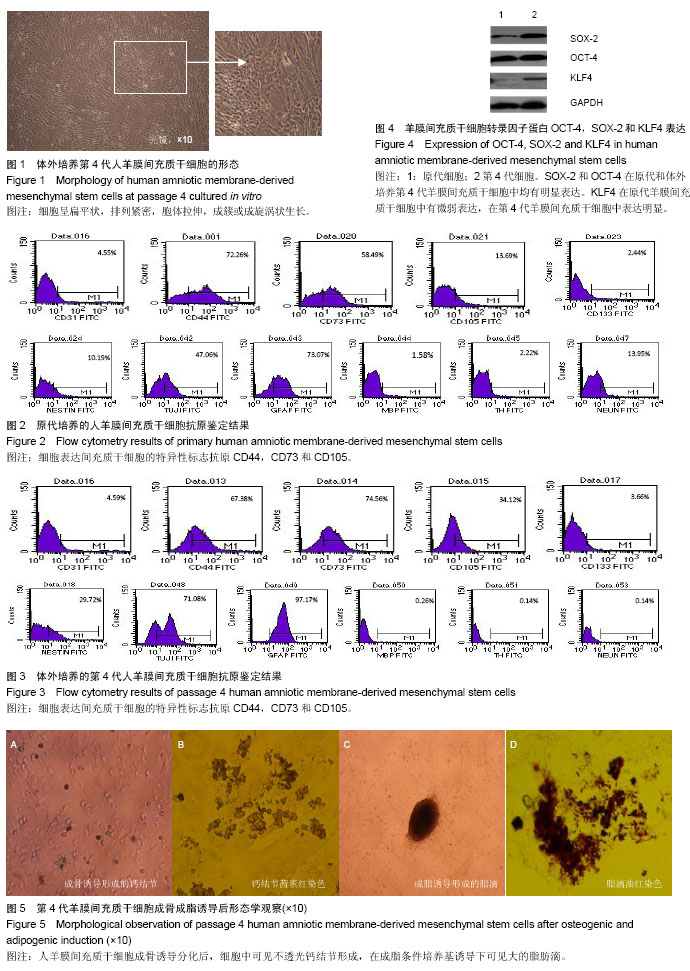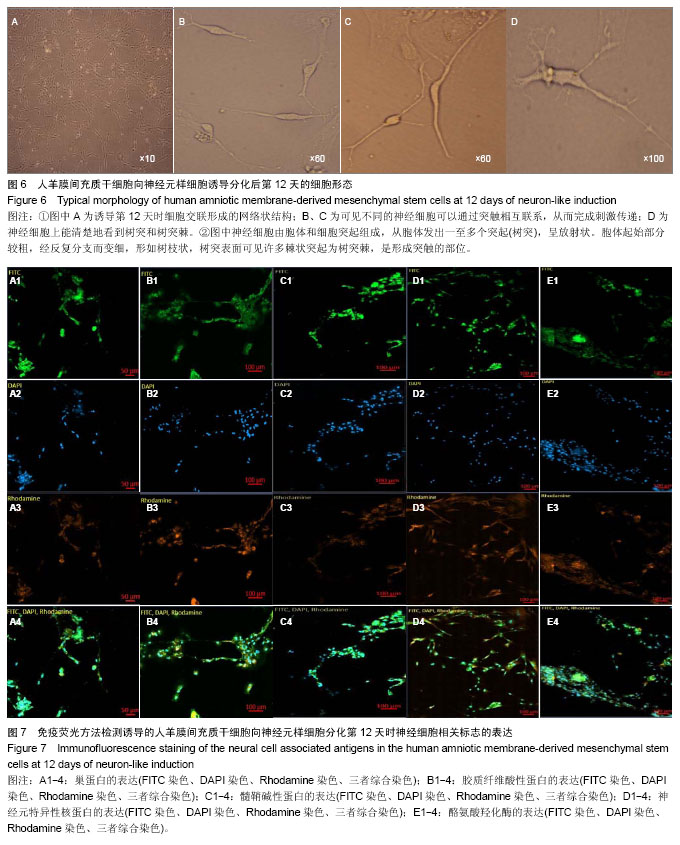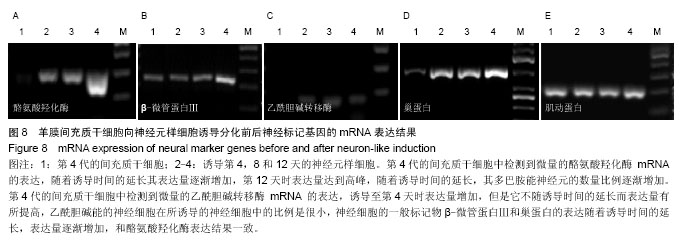| [1] 李艳华,白慈贤,谢超,等.成人骨髓间充质干细胞体外定向诱导分化为胰岛样细胞团的研究[J].自然科学进展,2003,13(6):593-597.
[2] 艾国平,粟永萍,闫国和,等.骨髓间充质干细胞的分离与培养[J]. 第三军医大学学报,2001,23(5):553-555.
[3] 李秀森,郭子宽,杨靖清,等.骨髓间充质干细胞的生物学特性[J]. 解放军医学杂志,2000,25(5):346-348.
[4] 方利君,付小兵,孙同柱,等.骨髓间充质干细胞分化为血管内皮细胞的实验研究[J].中华烧伤杂志, 2003,19(1):22-24.
[5] 刘晓丹,郭子宽,李秀森,等.人骨髓间充质干细胞分离与培养方法的建立[J].军事医学科学院院刊,2000,24(4):282-284.
[6] 方利君,付小兵,孙同柱,等.在体诱导骨髓间充质干细胞分化为表皮细胞的初步观察[J].中华创伤杂志,2003,19(4):19-21.
[7] 郭礼和.人羊膜上皮细胞具有胚胎干细胞和移植免疫耐受等优良特性[J].中国细胞生物学学报,2011,33(4):451-454.
[8] 喻皇飞,陈代雄.人羊膜细胞神经生物学性状研究进展[J].重庆医学,2011,40(32):3315-3317.
[9] Sakuragawa N, Thangavel R,Mizuguchi M, et al. Expression of markers for both neuronal and glial cells in human amniotic epithelial cells. Neurosci Lett. 1996;209(1):9-12.
[10] Sakuragawa N, Kakinuma K, Kikuchi A, et al. Human amnion mesenchyme cells express phenotypes of neuroglial progenitor cells. J Neurosci Res. 2004;78(2):208-214.
[11] Niknejad H, Peirovi H, Ahmadiani A, et al. Differentiation factors that influence neuronal markers expression in vitro from human amniotic epithelial cells. Eur Cell Mater. 2010;19:22-29.
[12] Miki T,Lehmann T, Cai H, et al.Stem cell characteristics of amniotic epithelial cells.Stem Cells. 2005;23(10):1549-1559.
[13] Ishii T, Ohsugi K, Nakamura S, et al. Gene expression of oligodendrocyte markers in human amniotic epithelial cells using neural cell-type-specific expression system. Neurosci Lett. 1999;268(3):131-134.
[14] Kim J, Park S, Kang HM, et al. Human insulin secreted from insulinogenic xenograft restores normoglycemia in type I diabetic mice without immunosuppression. Cell Transplant. 2012;21(10):2131-2147
[15] Kang JW, Koo HC, Hwang SY,et al. unomodulatory effects of human amniotic membrane-derived mesenchymal stem cells. J Vet Sci. 2012;13(1):23-31.
[16] König J, Huppertz B, Desoye G, et al. Amnion-derived mesenchymal stromal cells show angiogenic properties but resist differentiation into mature endothelial cells. Stem Cells Dev. 2012;21(8):1309-1320.
[17] Lisi A, Briganti E, Ledda M, et al. A combined synthetic-fibrin scaffold supports growth and cardiomyogenic commitment of human placental derived stem cells. PLoS One. 2012;7(4): e34284.
[18] Paracchini V, Carbone A, Colombo F, et al.Amniotic mesenchymal stem cells: A new source for hepatocyte-like cells and induction of cftr expression by coculture with cystic fibrosis airway epithelial cells. J. Biomed. Biotechnol. 2012; 2012:575471.
[19] Díaz-Prado S, Muiños-López E, Hermida-Gómez T, et al. Human amniotic membrane as an alternative source of stem cells for regenerative medicine. Differentiation. 2011;81(3): 162-171.
[20] Sivasubramaniyan K, Lehnen D, Ghazanfari R, et al. Phenotypic and functional heterogeneity of human bone marrow- and amnion-derived MSC subsets. Ann N Y Acad Sci. 2012;1266:94-106.
[21] Kawanabe N, Murata S, Fukushima H,et al. Stage-specific embryonic antigen-4 identifies human dental pulp stem cells. Exp Cell Res. 2012;318(5):453-463.
[22] Kim SW, Zhang HZ, Kim CE, et al. Amniotic mesenchymal stem cells have robust angiogenic properties and are effective in treating hindlimb ischaemia. Cardiovasc Res. 2012;93(3): 525-534.
[23] Kronsteiner B, Wolbank S, Peterbauer A, et al. Human mesenchymal stem cells from adipose tissue and amnion influence T-cells depending on stimulation method and presence of other immune cells. Stem Cells Dev. 2011; 20(12):2115-2126.
[24] 冶娟,慕晓玲.人胎盘源性间充质干细胞体外分离培养及多向分化潜能的研究[J].石河子大学学报(自然科学版),2012, 30(3): 351-355.
[25] Cargnoni A, Ressel L, Rossi D, et al. Conditioned medium from amniotic mesenchymal tissue cells reduces progression of bleomycin-induced lung fibrosis. Cytotherapy. 2012;14(2): 153-161.
[26] Manuelpillai U, Moodley Y, Borlongan CV, et al. Amniotic membrane and amniotic cells: Potential therapeutic tools to combat tissue inflammation and fibrosis? Placenta. 2011; 32(Suppl.4):S320-S325.
[27] 彭琳,王建,卢光琇.人羊膜间充质细胞的分离培养及向胰岛样细胞诱导分化[J].南方医科大学学报, 2011,31(01):5-10.
[28] 李海建,张广静,张兰,等.人羊膜间充质细胞分离培养及其干细胞特性研究[J].现代生物医学进展,2011,11(02):227-229.
[29] Takashima S,Ise H,Zhao P, et al. Human amniotic epithelial cells possess hepatocyte-like characteristics and functions. Cell Struct Funct. 2004;29(3):73-84.
[30] 蔡哲,周忠蜀,向青,等.人羊膜间充质细胞的神经生物学特性及其治疗帕金森模型小鼠的实验研究[J].中国康复理论与实践, 2010, 16(4):318-321+402-403.
[31] 陈娟.干细胞移植在缺血性脑卒中治疗中的应用[J].中国组织工程研究,2012,16(19):3576-3583
[32] 胡炜,杨枫唐,尤佳,等.羊膜间充质干细胞向运动神经元前体细胞的分化[J].中国组织工程研究,2012,16(36):6767-6773.
[33] 刘娟.体外诱导人羊膜细胞向神经细胞分化[D]. 遵义医学院, 2012.
[34] Hu W, Guan FX, Li Y, et al. New methods for inducing the differentiation of amniotic-derived mesenchymal stem cells into motor neuron precursor cells. Tissue Cell. 2013; 45(5): 295-305.
[35] Sun C, Shao J, Su L, et al. Cholinergic Neuron-Like Cells Derived From Bone Marrow Stromal Cells Induced by Tricyclodecane-9-yl-xanthogenate Promote Functional Recovery and Neural Protection After Spinal Cord Injury. Cell Transplantation. 2013;22(6):961-975.
[36] 金钧,黄坚,王俊,等.体外羊膜间充质干细胞分离培养及向神经元样细胞的分化[J].中国组织工程研究与临床康复,2010,14(32): 5939-5943.
[37] Deng J, Petersen B E, Steindler D A, et al. Mesenchymal stem cells spontaneously express neural proteins in culture and are neurogenic after transplantation. Stem cells. 2006; 24(4):1054-1064.
[38] Pacary E, Legros H, Valable S, et al. Synergistic effects of CoCl2 and ROCK inhibition on mesenchymal stem cell differentiation into neuron-like cells. Journal of cell science. 2006;119(13):2667-2678.
[39] Lee FJ,Liu F. Genetic factors involved in the pathogenesis of Parkinson's disease. Brain Res Rev. 2008;58(2):354-364.
[40] Kakishita K, Nakao N, Sakuragawa N, et al. Implantation of human amniotic epithelial cells prevents the degeneration of nigral dopamine neurons in rats with 6-hydroxydopamine lesions. Brain Res. 2003;980(1):48-56.
[41] 郭礼和,赵刚,刘天津.人羊膜细胞临床前研究:治疗神经退行性疾病方面的研究进展[J].中国细胞生物学学报,2011,33(6):720- 723. |



.jpg)